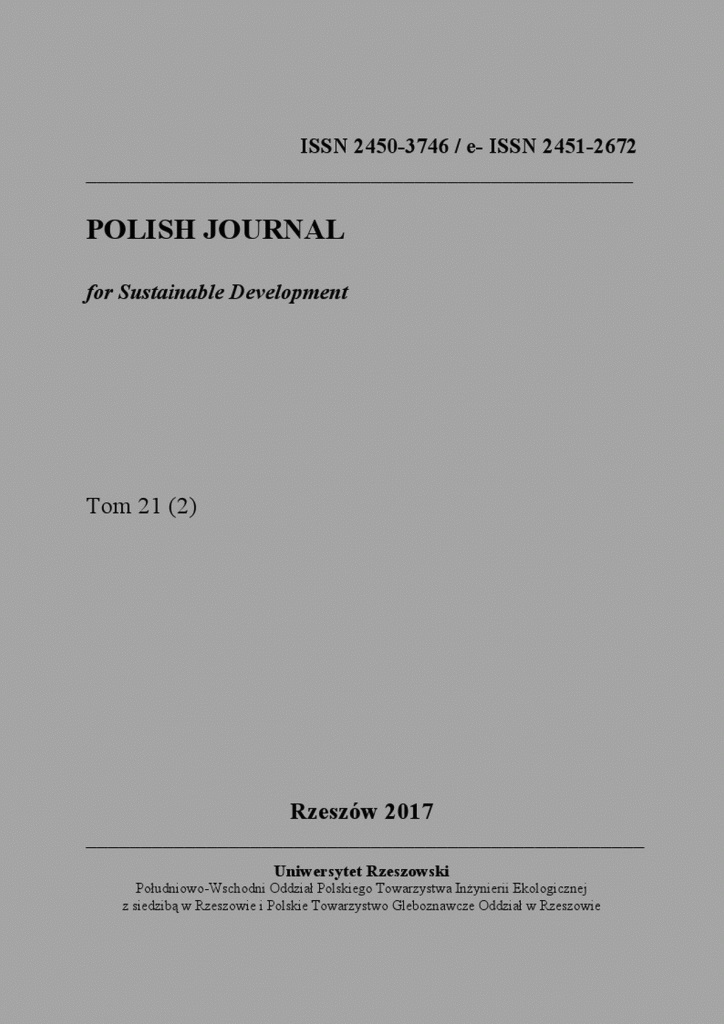Propagation of an artificial lighting in the atmosphere
DOI:
https://doi.org/10.15584/pjsd.2017.21.2.14Keywords:
light pollution, artificial airglow, light intensity, illuminance, light islandAbstract
The work discussed the problem of propagation of light originating from ground light sources. Such light impacts on the environment both directly as well as indirectly by dispersing on the atmospheric aerosols, contributing to the so-called artificial airglow. Such effect is especially important in the case of protected areas located in the vicinity of human settlements, which are the strong sources of light pollution. Extinction of light in the atmosphere, as well as terrain or vegetation causes that at a distance just a few kilometres from light source its direct impact on the environment is negligible. In case of an artificial airglow, the situation is more complex. The analysis of the measurement data collected within a few years has shown that artificial airglow is ecologically important only in the case of overcast sky and that the important factor is the cloud base. It seems that with the low clouds this effect is practically limited to the part of celestial sphere located directly above the light source and disappears very quickly with increasing distance. In case of a cloudless sky or with high clouds, the area of the lighted part of the sky is growing, but the contribution of light pollution in its surface brightness decreases significantly. This means that while the artificial airglow of the cloudless sky is an important problem in astronomical observations, it has a rather negligible ecological impact. The described analysis points to the need of protection of the near vicinity of protected areas first of all from defectively constructed ground lighting. It also indicates the possibility of preserving ecologically dark sky even in the vicinity of large urban centres. At the same time it confirms the necessity of location of astronomical observatories away from any human settlements.
Downloads
References
Atlas klimatu Polski pod redakcją Haliny Lorenc, Instytut Meteorologii i Gospodarki Wodnej 2005. Warszawa. 2005.
Bruehlmann S.M. 2014. Measuring and Mapping Light Pollution at a Local Scale. Faculty of Earth and Life Sciences. Vrije Universiteit Amsterdam. Netherlands
Cinzano P., Falchi F., Elvidge C.D. 2001a. Naked eye star visibility and limiting magnitude mapped from DMSP-OLS satellite data. MNRAS. 323. 34-46
Cinzano P., Falchi F., Elvidge C.D. 2001b. The first World Atlas of the artificial night sky brightness. MNRAS. 328. 689-707.
Cinzano P., Falchi F. 2012. The propagation of light pollution in the atmosphere. MNRAS. 427. 3337-3357.
Davies T.W., Bennie J., Inger R., Gaston K.J. 2013. Artificial light alters regimes of natural sky brightness. Scientific Reports. 3. 1722.
Ecological consequences of artificial night lighting. 2006. Rich C., Longcore T. [red.] Island Press.
Gliwicz M. Z. 1986. A lunar cycle in zooplankton. Ecology. 67. 883-897.
Joseph J.H., Kaufman Y.J., Mekler Y. 1991. Urban light pollution: the effect of atmospheric aerosols on astronomical observations at night. Appl. Opt. 30. 3047-3058.
Kaszowski W., Ściężor T., Kubala M. 2012. Wpływ warstw hamujących w atmosferze na sztuczną poświatę niebieską. [w:] Ochrona powietrza w teorii i praktyce. Tom 2. Zabrze 2012. 111-118.
Kubala M., Ściężor T., Dworak T.Z., Kaszowski W. 2009. Artificial Sky Glow in Cracow Agglomeration. Polish J. of Environ. Stud. 18. 3A. 194-199.
Kubala M., Ściężor T., 2012. Oświetlenie gruntu przez zanieczyszczone świetlnie nocne niebo. Interdyscyplinarne zagadnienia w inżynierii i ochronie środowiska 2. Oficyna Wydawnicza Politechniki Wrocławskiej. Wrocław 2012. 301-308.
Kyba C.C.M., Ruhtz T., Fischer J., Hölker F. 2011. Cloud Coverage Acts as an Amplifier for Ecological Light Pollution in Urban Ecosystems. PLoS ONE 6(3). e17307. doi:10.1371/journal.pone.0017307
Kyba C.C.M, Ruhtza T., Lindemanna C., Fischera J., Hölkera F., Luginbuhl C.B. 2012. Angular distribution of uplight at 10,000 ft over Berlin. Proceedings of the International Astronomical Union. 10. H16. 738-738
Longcore T., Rich C. 2004. Ecological light pollution. Frontiers in Ecology and the Environment. 2. 4. 191-198.
Schreuder D.A. 2001. Sky Glow Measurements in the Netherlands. [in:] Preserving the Astronomical Sky, R.J. Kohen, W.T. Sullivan III [eds.]. International Astronomical Union Sympodium. No. 196. Astronomical Society of the Pacific.
Seaman C. 2013. Beginner’s Guide to VIIRS Imagery Data. CIRA/Colorado State University. [dok. elektr.: http://rammb.cira.colostate.edu/projects/npp/Beginner_Guide_to_VIIRS_Imagery_Data.pdf, data wejścia: 21.10.2016]
Ściężor T., Kubala M., Kaszowski W., Dworak T.Z. 2010. Zanieczyszczenie świetlne nocnego nieba w obszarze aglomeracji krakowskiej. Analiza pomiarów sztucznej poświaty niebieskiej. Monografia. 388. Politechnika Krakowska. Kraków 2010.
Ściężor T., Kubala M. 2011. Zanieczyszczenie świetlne w otoczeniu wybranych zbiorników retencyjnych Małopolski. Czasopismo Techniczne – Środowisko. 108. 6. 235-245.
Ściężor T., Kubala M. 2012. Wpływ chmur niskich i wysokich na bliskie i dalekie zanieczyszczenie świetlne. Czasopismo Techniczne. 2-Ś. 109. 23. 253-260.
Ściężor T. 2013. A new astronomical method for determining the brightness of the night sky and its application to study long-term changes in the level of light pollution. MNRAS. 435. 303-310. doi: 10.1093/mnras/stt1297.
Ściężor T., Kubala M. 2014. Particulate matter as an amplifier for astronomical light pollution. MNRAS. 444. 2487-2493. doi: 10.1093/mnras/stu1577.
Walczewski J. 1994. Charakterystyka warstwy granicznej nad miastem (na przykładzie Krakowa). Mat. Bad. IMGW. seria Meteorologia. 22. IMGW. Warszawa 1994.
Downloads
Published
Issue
Section
License
Copyright (c) 2017 Polish Journal for Sustainable Development

This work is licensed under a Creative Commons Attribution-NonCommercial-NoDerivatives 4.0 International License.


